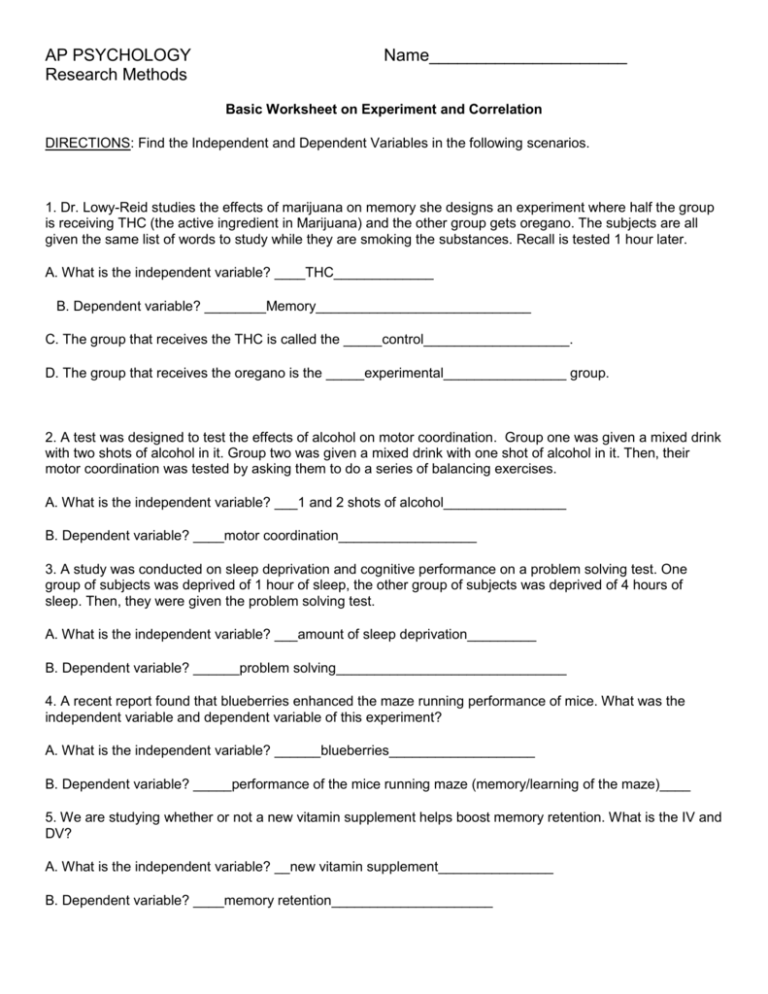answers here!
advertisement

AP PSYCHOLOGY Research Methods Name_____________________ Basic Worksheet on Experiment and Correlation DIRECTIONS: Find the Independent and Dependent Variables in the following scenarios. 1. Dr. Lowy-Reid studies the effects of marijuana on memory she designs an experiment where half the group is receiving THC (the active ingredient in Marijuana) and the other group gets oregano. The subjects are all given the same list of words to study while they are smoking the substances. Recall is tested 1 hour later. A. What is the independent variable? ____THC_____________ B. Dependent variable? ________Memory____________________________ C. The group that receives the THC is called the _____control___________________. D. The group that receives the oregano is the _____experimental________________ group. 2. A test was designed to test the effects of alcohol on motor coordination. Group one was given a mixed drink with two shots of alcohol in it. Group two was given a mixed drink with one shot of alcohol in it. Then, their motor coordination was tested by asking them to do a series of balancing exercises. A. What is the independent variable? ___1 and 2 shots of alcohol________________ B. Dependent variable? ____motor coordination__________________ 3. A study was conducted on sleep deprivation and cognitive performance on a problem solving test. One group of subjects was deprived of 1 hour of sleep, the other group of subjects was deprived of 4 hours of sleep. Then, they were given the problem solving test. A. What is the independent variable? ___amount of sleep deprivation_________ B. Dependent variable? ______problem solving______________________________ 4. A recent report found that blueberries enhanced the maze running performance of mice. What was the independent variable and dependent variable of this experiment? A. What is the independent variable? ______blueberries___________________ B. Dependent variable? _____performance of the mice running maze (memory/learning of the maze)____ 5. We are studying whether or not a new vitamin supplement helps boost memory retention. What is the IV and DV? A. What is the independent variable? __new vitamin supplement_______________ B. Dependent variable? ____memory retention_____________________ CORRELATIONS: DO YOU UNDERSTAND THEM? Directions: State whether the correlation is positive or negative using + or – in the spaces provided. Jot down possible intervening variables might explain the results. (Some examples are imaginary!) __+____6. The more rooms a person has in their house, the more pairs of shoes they are likely to own. __-____7. The more class days students miss, the lower their grades are likely to be. __-____8. The more expensive a person's car is, the fewer successful intimate relationships they have. __-____9. More educated people tend not to buy designer label clothing. __-____10. The more alcohol a person drinks, the lower their scores on performance tests. __-____11. The fewer friends an elderly person has, the more likely they are to have symptoms of depression. __+____12. The more selections from Mozart that a baby listens to, the higher the child’s intelligence scores. __-____13. The fewer fruits and vegetables a person eats, the more likely they will get cancer. __+____14. The more languages you speak, the higher your scores on mathematics. __+____15. The more chocolate your teacher eats before class, the more likely she is to tell jokes . EXPERIMENTAL ANALYSIS: Dr. Antonio Ruane is a developmental psychologist who loves his work. It is a great profession except that he can never get away from work! One area of interest for him is toilet training because parents always ask how to do it faster and neater. He was out at a restaurant sitting next to a table of boy toddlers and their parents. (It wasn’t the best eating event for him.) Dr. Ruane did become fascinated as the boys made targets out of everything. The boys even threw wads of napkins at his water glass – fortunately, their aim wasn’t that good. It got him to thinking, though, about boys and targets and whether he could use this for toilet training. He decided to set up an experiment. Dr. Ruane enlisted 10 daycare centers that agreed to participate. He wrote letters to parents asking if they would allow their children to be subjects in his study. He only used boys in this study due to anatomical and maturational differences between the sexes. A number of parents agreed to participate, and he randomly assigned their sons to different groups. One group of day care providers and parents received instructions to throw Cheerios in the toilet for the boys to aim at. The other group did not use targets and just followed the traditional toilet training. Dr. Ruane charted the time it took to become accident free, i.e. toilet trained. He was delighted to find that the ‘Cheerio boys’ trained in half the time, when compared to the traditional potty training boys. (As you might imagine, the makers of Cheerios were delighted!) 16. What was Dr. Ruane’s theory? Using Cheerios as targets would be fun and speed potty-training time for boys. 17. What was his hypothesis? Same 18. Independent variable? Why? Cheerios 19. Dependent variable? Why? Potty training time 20. Did he get a random assignment of subjects? Why or why not? Yes- half the boys were selected to have the Cheerios (experimental group) Half were not (control group) 21. Did he prove his hypothesis? (Prove causation) Students may discuss this—from the information given, it appears that the use of Cheerios worked. Are there any other confounding variables that may have impacted the boys? Below are examples of research studies. Name the independent variable (IV) and the dependent variable (DV) for each one. Then check your results with the answers. A good tip for doing this exercise is to first name the 2 main variables in the study, then figure out which one influences the other. The one doing the influencing is the IV; the one being influenced is the DV. 1. Study examining if t.v. violence increases aggression in children. IV: tv violence DV- increased aggression 2. Study predicting that alcohol drinking will decrease people's reaction time while driving. IV: Alcohol intake DV: reaction time while driving. 3. Study examining if perspective taking improves with age. IV. Age DV test taking 4. Study predicting that high school sports build character. IV sport participation DV character building 5. How do changes in work space affect employee reaction? IV change workspace DV employee response 6. Study predicting that pedestrians will walk faster on hot days versus cold days. IV cold DV walk faster 7. Are younger siblings treated better by their parents than older siblings? IV younger siblings DV better treatment IV older sibling DV worse treatment .








